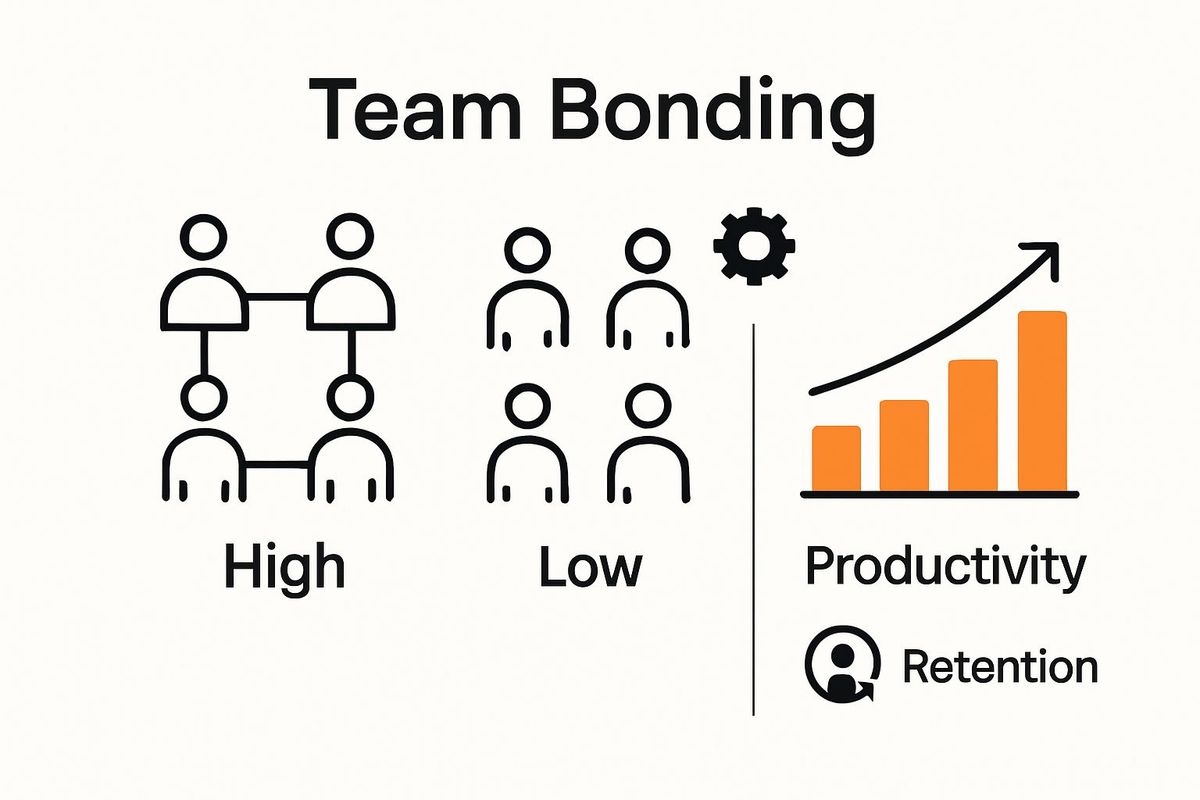Understanding What is Team Bonding and Why It Matters
October 11, 2025

Team bonding runs much deeper than a fun icebreaker or free pizza at work. Studies show that teams with strong connections can outperform others by up to 20 percent. Surprisingly, it is not the social perks that matter most. The real impact comes from building psychological safety and trust, turning everyday coworkers into a unit that thrives on collaboration and shared purpose.
Table of Contents
- Defining Team Bonding: Key Concepts And Objectives
- The Importance Of Team Bonding In The Workplace
- The Science Behind Team Bonding: How It Works
- Effective Team Bonding Activities And Their Impact
- Building A Stronger Workplace Culture Through Team Bonding
Quick Summary
| Takeaway | Explanation |
|---|---|
| Team bonding enhances workplace relationships. | It creates intentional opportunities for connection, fostering trust and mutual understanding among employees. |
| Effective bonding improves organizational performance. | Engaged teams show higher productivity, better problem-solving, and increased employee retention. |
| Psychological safety boosts creativity and collaboration. | Employees who feel safe sharing ideas and taking risks contribute more authentically and creatively. |
| Structured activities foster meaningful connections. | Purposeful team bonding experiences enhance interpersonal dynamics and reveal individual strengths. |
| Strong culture requires intentional team bonding. | By promoting genuine interactions, organizations can translate abstract values into lived cultural practices. |
Defining Team Bonding: Key Concepts and Objectives
Team bonding represents a strategic approach to enhancing workplace relationships and group dynamics through purposeful collaborative experiences. At its core, team bonding goes beyond simple social interactions by creating intentional opportunities for employees to connect, communicate, and develop mutual understanding in meaningful ways.
The Fundamental Nature of Team Bonding
Research from organizational psychology reveals that team bonding is not just about creating pleasant experiences, but about developing psychological safety and interpersonal trust within professional environments. The primary objectives of team bonding include:
- Improving communication channels between team members
- Reducing workplace conflicts and misunderstandings
- Enhancing collaborative problem solving capabilities
When teams engage in deliberate bonding activities, they transform from a collection of individuals into a cohesive unit with shared goals and mutual respect. This process requires structured interactions that challenge employees to work together outside their typical professional roles.
Strategic Approaches to Building Team Connection
Effective team bonding transcends traditional team building by focusing on deeper psychological and emotional connections. Unlike superficial social events, these experiences are designed to uncover complementary strengths, challenge existing communication patterns, and create shared narrative experiences that bind team members together.
The most successful team bonding initiatives recognize that genuine connection cannot be forced but must be facilitated through carefully designed experiences that feel authentic and engaging. Read more about encouraging team bonding to understand how organizations can create meaningful interaction opportunities.
Ultimately, team bonding is about transforming workplace relationships from transactional interactions to genuine human connections that foster trust, mutual understanding, and collective achievement. By investing in these strategic experiences, organizations can create more resilient, adaptable, and high performing teams.
The Importance of Team Bonding in the Workplace
Team bonding is not a luxury but a critical strategic investment that directly impacts organizational performance, employee satisfaction, and overall workplace culture. Modern businesses recognize that strong interpersonal connections are fundamental to creating high performing teams that can navigate complex professional challenges.
Driving Organizational Performance
Research from Gallup demonstrates that teams with high levels of engagement and connection outperform their less connected counterparts by significant margins. The tangible benefits of effective team bonding include:

- Increased productivity and collaborative efficiency
- Higher employee retention rates
- Improved problem solving and innovation capacity
When employees feel genuinely connected to their colleagues, they develop a sense of shared purpose that transcends individual tasks. This emotional investment transforms workplace dynamics from transactional interactions to meaningful professional relationships.
Psychological and Emotional Impact
Beyond measurable performance metrics, team bonding plays a crucial role in creating psychological safety. Employees who feel comfortable expressing ideas, sharing vulnerabilities, and taking calculated risks are more likely to contribute creatively and authentically. Explore our guide on ways to promote teamwork to understand how intentional connection strategies can reshape workplace interactions.
The emotional intelligence cultivated through deliberate team bonding activities helps mitigate workplace stress, reduce interpersonal conflicts, and create a more supportive professional environment. By investing in these experiences, organizations signal that they value human connections as much as professional competencies.
Ultimately, team bonding represents a sophisticated approach to organizational development. It transforms workplace relationships from mere professional networks into dynamic, supportive ecosystems where individual talents can flourish collectively. The most successful companies understand that their greatest asset is not just individual talent, but the synergistic potential created when those talents are meaningfully connected.
This table summarizes the core benefits of team bonding for employees and organizations, along with the related organizational outcomes mentioned in the article.
| Benefit | Employee Impact | Organizational Outcome |
|---|---|---|
| Improved Communication | Fewer misunderstandings and conflicts | Higher productivity |
| Enhanced Psychological Safety | Increased creativity and willingness to take risks | More innovation and effective collaboration |
| Stronger Trust | Greater comfort sharing ideas and vulnerabilities | Higher retention and employee satisfaction |
| Shared Purpose | Higher engagement | Increased collective performance (up to 20%) |
| Reduced Stress | Better emotional well-being | More supportive work environment |
The Science Behind Team Bonding: How It Works
Team bonding is more than a simple workplace activity. It is a sophisticated psychological intervention that leverages neurological and social science principles to transform group dynamics and enhance collective performance. Understanding the underlying mechanisms reveals why these experiences are so powerful in reshaping workplace interactions.
Neurochemical Foundations of Connection
Research from the American Psychological Association reveals that team bonding activities trigger complex neurochemical responses that fundamentally alter how team members perceive and interact with each other. When individuals engage in shared experiences, their brains release oxytocin and dopamine, neurotransmitters associated with trust, bonding, and positive emotional states.
The neurological impact of team bonding includes:
- Reduction of cortisol stress hormones
- Enhanced empathy and emotional intelligence
- Increased sense of psychological safety
These neurochemical changes create a biological foundation for improved workplace relationships, making team members more receptive to collaboration and mutual understanding.
Social Learning and Group Dynamics
Team bonding experiences function as powerful social learning environments where individuals can observe and adapt to each other's communication styles, strengths, and potential complementary skills. Explore our insights on building team cohesion to understand how structured interactions can accelerate group development.
By creating scenarios that require collective problem solving, shared risk taking, and mutual support, these activities help teams develop unspoken communication protocols and shared mental models. This goes beyond simple socializing, creating deep structural changes in how team members perceive and respond to one another.
Ultimately, team bonding is a scientifically grounded approach to organizational development. It recognizes that human connection is not a soft skill, but a complex neurological and social process that can be strategically designed to enhance collective performance and individual well being.
Effective Team Bonding Activities and Their Impact
Team bonding activities are strategic experiences designed to transform professional relationships from transactional interactions into meaningful collaborative connections. The most successful activities transcend superficial entertainment, instead creating purposeful opportunities for genuine interpersonal engagement and skill development.
Characteristics of High Impact Team Bonding
Research from organizational psychology demonstrates that effective team bonding activities share several critical characteristics. These experiences must be intentionally structured to challenge teams, promote communication, and reveal individual and collective strengths.
Key elements of impactful team bonding include:
- Activities that require genuine collaboration
- Experiences outside typical workplace hierarchies
- Challenges that encourage creative problem solving
The most transformative activities create environments where team members can interact authentically, breaking down formal professional barriers and discovering complementary skills and perspectives.
The following table highlights the key characteristics that distinguish high-impact team bonding activities from traditional, less effective methods.
| Characteristic | High-Impact Team Bonding | Traditional Team Building Events |
|---|---|---|
| Collaboration Required | Genuine, essential | Often optional or surface-level |
| Workplace Hierarchies | Activities outside formal structure | Usually within existing hierarchies |
| Challenge Level | Encourages creative problem solving | May lack significant challenge |
| Communication | Promotes open, authentic exchange | Limited to structured roles |
| Personal Strengths Revealed | Individual and team strengths emerge | Less focus on individual strengths |
| Lasting Impact on Culture | Strong, transformative | Typically short-lived impact |
Strategic Activity Design and Outcomes
Successful team bonding goes far beyond traditional team building exercises. These activities are carefully designed psychological interventions that strategically reshape group dynamics. Learn more about defining team building success to understand the nuanced approaches modern organizations employ.
Highly effective team bonding activities typically involve experiential learning, where participants actively engage in challenges that require collective intelligence. This might include complex problem solving scenarios, collaborative creative projects, or shared risk taking experiences that demand mutual trust and communication.
Ultimately, team bonding activities are not just events but sophisticated organizational development tools. By creating structured opportunities for genuine connection, companies can transform workplace relationships, enhance collective performance, and build resilient, adaptive teams capable of navigating complex professional challenges.
Building a Stronger Workplace Culture Through Team Bonding
Workplace culture represents the invisible infrastructure that determines organizational success, employee satisfaction, and long term performance. Team bonding emerges as a powerful mechanism for intentionally shaping and reinforcing this complex cultural ecosystem, transforming abstract organizational values into tangible shared experiences.
Cultural Architecture and Interpersonal Dynamics
Research from Gallup reveals that organizations with strong, positive cultures experience significantly higher employee engagement, productivity, and retention. Team bonding activities serve as strategic interventions that deliberately construct these cultural foundations by creating opportunities for meaningful interaction beyond traditional work responsibilities.
Essential cultural development elements include:
- Establishing trust and psychological safety
- Breaking down hierarchical communication barriers
- Creating shared narrative experiences
These interactions help dissolve formal workplace boundaries, enabling employees to perceive each other as multidimensional individuals rather than mere professional roles. This humanization of workplace relationships forms the cornerstone of a resilient, adaptive organizational culture.

Transforming Organizational Values into Lived Experiences
Team bonding transcends superficial socializing by providing structured environments where abstract organizational values become tangible behaviors. Explore our guide on promoting teamwork to understand how intentional experiences can translate corporate mission statements into genuine collaborative practices.
By designing activities that challenge teams to collaborate, problem solve, and support one another, organizations can operationalize their cultural aspirations. These experiences become living demonstrations of desired workplace behaviors, teaching employees how to embody organizational principles through direct, meaningful interaction.
Ultimately, team bonding represents a sophisticated approach to cultural engineering. It recognizes that workplace culture is not a static concept, but a dynamic, continuously evolving system that requires deliberate, strategic cultivation through thoughtful, purposeful human connection.
Turn Team Bonding Insights Into Real Workplace Change
Are you searching for a way to transform your team's communication and collaboration into lasting results? The article you just read highlights the difficulties teams face when connections remain surface-level or when trust and psychological safety feel out of reach. Genuine team bonding is essential to break down barriers, encourage creative problem solving, and support a true sense of belonging. But discussing these ideas is only the first step. You need practical tools that can bring these principles to life for your group today.

Bring your team bonding strategy to action with a solution trusted by organizations worldwide. With the quizado.com platform, you can easily create customized quiz games that foster authentic collaboration and strengthen workplace relationships. Explore flexible, professional tools for quiz creation, personalized branding, and engaging team play, both online and offline.
Take the next step and see how our customizable quiz experiences can help you unlock the full potential of your team. Get started now by visiting quizado.com and discover how easy it is to turn insight into action—or read more about encouraging team bonding and building team cohesion to refine your approach. Create moments that connect, inspire, and move your team forward with purpose.
Frequently Asked Questions
What is team bonding?
Team bonding is a strategic process designed to improve workplace relationships through purposeful collaborative experiences. To implement team bonding, create opportunities for team members to connect and engage with each other in meaningful ways.
Why does team bonding matter in the workplace?
Team bonding is crucial because it enhances communication, reduces conflicts, and fosters trust among team members. Focus on organizing activities that encourage authentic interactions, which can lead to higher employee satisfaction and productivity.
How can I implement effective team bonding activities?
To implement effective team bonding, select activities that require genuine collaboration and shared problem-solving. Aim to conduct these activities monthly, ensuring that they challenge teams while promoting a sense of unity and cooperation.
What are the benefits of team bonding for employees?
The benefits of team bonding for employees include improved psychological safety, higher engagement, and better retention rates. To maximize these benefits, create an environment where employees feel comfortable sharing ideas and vulnerabilities during bonding activities.
How does team bonding impact overall organizational culture?
Team bonding positively impacts organizational culture by transforming interpersonal dynamics and aligning employee behaviors with company values. Begin by integrating bonding activities into your regular schedules to reinforce cultural principles consistently.
How can team bonding increase productivity?
Team bonding can increase productivity by creating a sense of shared purpose and enhancing collaborative efficiency among team members. Track improvements and aim for a productivity increase of approximately 20% within the first few months of implementing bonding activities.



